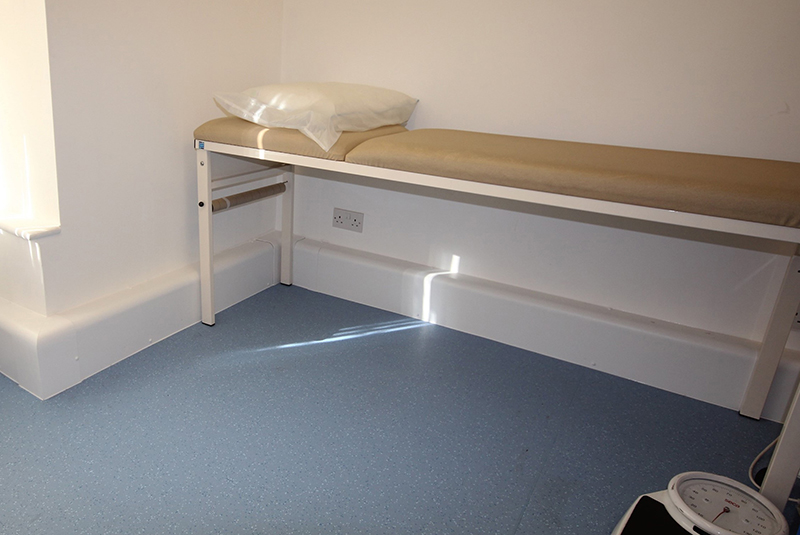
In many domestic, commercial and public sector properties, heating and plumbing pipework will need to be concealed for aesthetic purposes. But, in some buildings, particularly those used and occupied by vulnerable people, covering pipework, as well as radiators, can be a necessity. Richard Braid, Managing Director of Pendock, explains more.
It’s common for installers to be asked to conceal, or ‘box in’, the heating and plumbing pipework they fit for aesthetic purposes; for some people, pipes are unsightly and need to be hidden. In some buildings, however, concealing pipework is about more than aesthetics; safety concerns make it a necessity. Exposed pipework that’s circulating hot water can pose a burn risk – as can radiators. According to NHS data, there were 838 hospital admissions in England between April 1st 2018 and March 31st 2019 due to unintentional injury by contact with hot heating appliances, radiators and pipes.
The risks are usually greater for vulnerable groups, such as the elderly, children, people with reduced mental capacity, mobility or temperature sensitivity and people who cannot react appropriately, or quickly enough, to prevent injury. Therefore, when installing heating systems or fitting bathrooms in public sector buildings such as surgeries, clinics and health centres, care homes, schools and leisure centres – which are used or occupied by these groups – installers will usually need to cover the ancillary pipework, as well as the radiators.
In some properties, all the pipework and radiators will need to be boxed in, whereas in others it will be a requirement for certain areas – usually identified through risk assessments. For example, in care homes, burns from pipework and radiators might be more likely to occur in areas with low levels of supervision, such as bedrooms, bathrooms and some communal areas, where people might accidently fall against or touch a hot surface and be unable to get immediate help. However, we’d always recommend that all hot surfaces are covered to reduce risks.
Guidance documents
Several guidance documents state that surface temperatures shouldn’t exceed 43°C. A Health & Safety Executive (HSE) health and social care information sheet says that where vulnerable people may come into prolonged contact with hot surfaces, the guidance is for the equipment to be designed or covered so the maximum accessible surface temperature does not exceed 43°C.
Similarly, the Education (School Premises) Regulations state that in a special school, nursery school or teaching accommodation used by a nursery class in a school, the surface temperature of any radiator, including exposed pipework, which is in a position where it may be touched by a pupil shall not exceed 43°C. Meanwhile, in Section 5 of Approved Document M: access to and use of buildings, volume 2 – buildings other than dwellings, the guidance is for any heat emitters in sanitary accommodation to be either screened or have their exposed surfaces kept at a temperature below 43oC.
Where concealing heating and plumbing pipework is concerned, it’s important for installers to deliver a neat, consistent, aesthetically pleasing finish – and, if working in public sector buildings, they’ll probably also need to keep to tight budgets.
Uniform finish
Installers can pass boxing in work onto joiners or carpenters, or can tackle it themselves. Today’s pre-formed, made-to-measure options make it easier for installers to keep control of the work. Rather than having to fabricate a solution on site – a time-consuming process involving cutting wood or MDF to size, fixing it around the pipework and priming and painting it (which doesn’t always deliver consistent results) – installers can use pre-formed pipe boxing, enabling them to easily achieve a uniform finish.
Pre-formed products are simple to fit, whether covering horizontal or vertical pipework, or pipework that runs around corners. Few components are required; just batten, pre-formed profiles, screws, mastic sealant and, if required, external and internal corner pieces (eliminating the need to fabricate mitre joints – a job that’s often passed onto a joiner). There’s minimal cutting involved, and no painting required.
While the initial upfront cost of pre-formed solutions might seem more expensive than buying lengths of wood or MDF to fabricate on site, when the time savings are considered (we estimate they take half the time to fit compared to onsite fabrication), along with the aesthetic benefits and consistency of fit and finish, pre-formed pipe boxing is cost-effective.
If pipework needs to be accessed in the future, pre-formed products can be easily removed and refitted (it might not be so straightforward to remove boxing in that was fabricated on site without causing damage and refurbishment costs) and access panels can also be fitted.
LST radiators
Ensuring radiators have a safe surface temperature is also straightforward. Low surface temperature (LST) guards fit neatly over existing radiators, reducing the surface temperature to a safe level. Where surface temperatures must not exceed 43°C, a baffle can be fitted below the grille to ensure guaranteed control. High-quality products have pre-formed skirting cut outs and valve access panels to make installations quick, simple, neat and consistent.
When selecting products, it’s important for installers to consider the quality and longevity of the material the guards are manufactured from. The radiator’s heat output, performance and energy efficiency shouldn’t be affected, and there shouldn’t be any surface hot spots. LST radiator guards at the budget end of the market can potentially be more susceptible to damage and might be difficult to clean and maintain. An antibacterial coating that will kill MRSA, Salmonella, E. coli and C. difficile is included as standard on all Pendock radiator guards, and products can be supplied with a drop-down lockable panel for routine cleaning, inspection and maintenance.
In public sector buildings used and occupied by vulnerable people, it is usually necessary for heating and plumbing pipework and radiators to be concealed to reduce the risk of burns. Pre-formed pipe boxing and LST radiator guards are simple, cost-effective solutions that help heating and plumbing installers to deliver effective, neat, consistent results.












